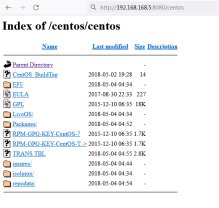Centos7 用http ftp搭建本地yum源
文章标签: centos linux 服务器
一、环境准备
1.准备2-3台虚拟机,一台为服务端(安装yum源),其余的为客户端(测试yum源安装结果),最好是同网段的。
IP地址 角色 备注
192.168.116.5 服务端 将完整镜像上传到这台机器
192.168.116.15 客户端
2.准备镜像文件,这里以CentOS-7-x86_64-2009,当然最好是使用CentOS-7-x86_64-Everything-2207-02.iso(这是完整版,包含了所有软件组件,当然体积也庞大,高达9.58G。对完整版安装盘的软件进行补充,集成所有软件;不要使用mini版)
3.准备远程软件,secucrt或者FinalShell、xshell都可
4.关闭防火墙,每一台都要关闭,包括selinux。
root@test1 yum.repos.d\]# systemctl stop firewalld \[root@test1 yum.repos.d\]# systemctl disabled firewalld //设置防火墙开机不自启 root@test1 yum.repos.d\]# setenforce 0 //将selinux临时状态调整为开启 \[root@test1 yum.repos.d\]# getenforce //查看selinux状态 5.备份yum源 \[root@test1 \~\]# cd /etc/yum.repos.d //yum的配置文件所在 \[root@test1 yum.repos.d\]# mkdir bak \[root@test1 yum.repos.d\]# mv \*.repo bak/ \[root@test1 yum.repos.d\]# ls bak //注每台机器都要进行这一步操作 6.创建yum_http.repo文件 (本地yum源) \[root@test1 yum.repos.d\]# vi yum_http.repo 将一下内容写入 \[centos
name=centos
baseurl=file:///opt/centos
gpgcheck=0
enabled=1
7.创建目录将镜像上传至/opt/centos
root@test1 yum.repos.d\]# mkdir /opt/centos \[root@test1 yum.repos.d\]# cd /opt/centos \[root@test1 centos\]# ls CentOS-7-x86_64-DVD-2009.iso \[root@test1 centos\]# mount /opt/centos/CentOS-7-x86_64-DVD-2009.iso /opt/centos //挂载镜像文件,简单挂载mount: /dev/loop0 写保护,将以只读方式挂载 8.安装createrepo \[root@test1 html\]# yum install -y createrepo //利用createrepo 创建yum源仓 二、用http服务,配置yum源 1.安装httpd服务 \[root@test1 yum.repos.d\]# yum -y install httpd 2.配置httpd服务 \[root@test1 \~\]# cd /var/www/html/ //进入到httpd的默认目录 将/opt/centos下挂载的文件软连接到http默认访问目录下,当然也可以使用cp命令,不过镜像文件较大,使用软连接更快 \[root@test1 html\]# ln -s /opt/centos/ /var/www/html/ \[root@test1 html\]# ll 总用量 0 lrwxrwxrwx 1 root root 12 7月 8 16:06 centos -\> /opt/centos/ 或者cp 复制 \[root@test1 html\]# mkdir centos \[root@test1 html\]# cp -r /opt/centos/\* /var/www/html/centos \[root@test1 html\]# createrepo /var/www/html/centos Spawning worker 0 with 993 pkgs Spawning worker 1 with 993 pkgs Spawning worker 2 with 993 pkgs Spawning worker 3 with 992 pkgs 3.启动httpd服务 \[root@test1 yum.repos.d\]# systemctl start httpd 可以在网页上测试一下http://192.168.168.5:8080/centos  4.另外找一台服务器,修改http.repo(这里以自己创建的名字为准)文件中的baseurl为服务端ip \[root@test3 yum.repos.d\]# vim http.repo \[centos
name=centos
baseurl=http://192.168.168.5:8080/centos
gpgcheck=0
enabled=1
最后做测试
root@test3 yum.repos.d\]# yum -y install vim //可以安装则代表成功 * 用vsftpd配置yum源 1.安装vsftpd服务 \[root@test1 yum.repos.d\]# yum -y install vsftpd 2.配置vsftpd服务 \[root@test1 \~\]# cd /var/ftp/pub/ //进入到vsftpd的默认目录 将/opt/centos下挂载的文件软连接到ftp默认访问目录下,当然也可以使用cp命令,不过镜像文件较大,使用软连接更快 \[root@test1 pub\]# ln -s /opt/centos/ /var/ftp/pub/ \[root@test1 pub\]# ll 总用量 0 lrwxrwxrwx 1 root root 12 7月 8 16:06 centos -\> /opt/centos/ 或者cp 复制 \[root@test1 pub\]# mkdir centos \[root@test1 pub\]# cp -r /opt/centos/\* /var/ftp/pub/centos 用 createrepo 创建仓库 \[root@test1 pub\]# createrepo /var/ftp/pub/ Spawning worker 0 with 993 pkgs Spawning worker 1 with 993 pkgs Spawning worker 2 with 993 pkgs Spawning worker 3 with 992 pkgs 3.启动vsftpd服务 \[root@test1 yum.repos.d\]# systemctl start httpd 可以在网页上测试一下ftp://192.168.168.5/pub 有内容则代表成功 4.另外找一台服务器,修改http.repo(这里以自己创建的名字为准)文件中的baseurl为服务端ip \[root@test3 yum.repos.d\]# vi ftp.repo \[ftpyum
name=ftpyum
baseurl=ftp://192.168.168.5/pub
enabled=1
gpgcheck=0
最后做测试
root@test3 yum.repos.d\]# yum -y install vim //可以安装则代表成功